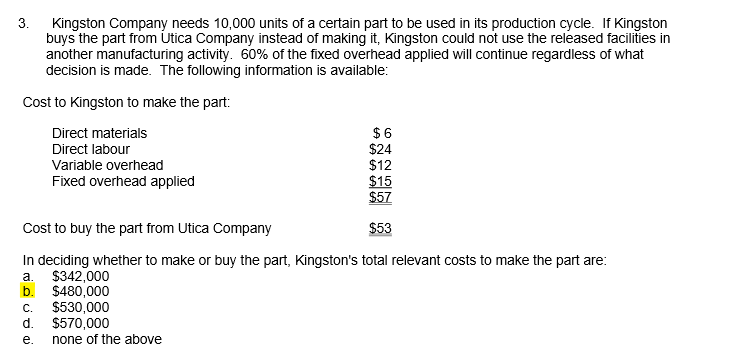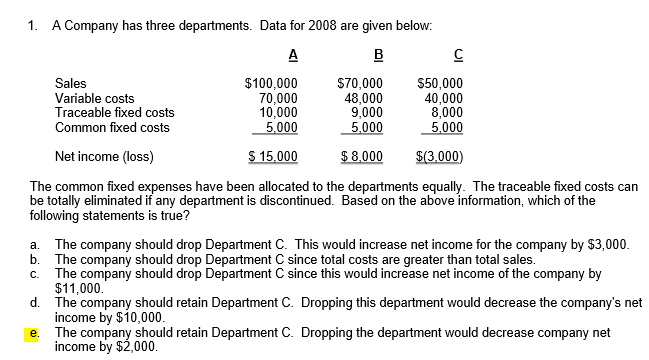ch. 7 - incremental analysis
1/16
There's no tags or description
Looks like no tags are added yet.
Name | Mastery | Learn | Test | Matching | Spaced |
|---|
No study sessions yet.
17 Terms
op cost
The amount of profit foregone because you didn't use a limited resource in the best use
differential/incremental cost
The difference in cost between two alternatives
outlay cost
A cost that requires a cash disbursement
useful info requirements
Accuracy
Timeliness
Relevancy
relevant info
Two requirements
Affects future cash flows quantitatively
Something unique between competing alternatives
If it's not then it does not matter
ex. Cash you receive from selling an asset
ex. Avoidable issues
ex. a change in a fixed cost
Exception
Opportunity costs are always relevant
irrelevant ex.
Sunk costs
Not in the future
Depreciation
Not a physical loss of money
Which is why NBV or caring amount is also irrelevant
Loss or gain on a sale
Not a physical loss of money
Allocated/common fixed costs
Not in the future
Unavoidable issues
Will be there no matter what
one time only special orders
Occurs if you are customizing a product or buying in bulk (order is only placed once)
Look at:
Incremental cash inflows v. incremental cash outflows and their opportunity cost
Accept if
Inflows> outflows
Reject if
Inflows< outflows
Indifferent if
Inflows= outflows
selling price for bulk formula
Selling price - vc = cm
Min selling price = vc costs
When you don’t know cm, use this
insourcing v. outsourcing
Cost to make v. Cost to buy
Incremental cash outlay + op cost of forgoing something else v. External purchase price
No opportunity cost for;
Idle machinery
Buying
ex. dealing with fixed overhead( total costs)
what you are saving by outsourcing
to deal with the fixed overhead, we need to first multiply everything by 25,000 (units) to get a total
vc = 25,000*(1.5+2.5+0.8) = 120,000
fc overhead = 10,000
selling 2-0.8 = 1.2 *25,000 = 30,000
total savings = 120,000+10,000+30,000 = 160,000
savings per unit = 160,000/25,000 = 6.4

ex. of finding relevant costs
relevant costs
6+24+12+(0.4*15) = 48
48*10,000 = 480,000

adding/dropping product lines or dept.
deciding on removing or retaining your offerings
look at qualitative aspects along with quantitative
purposely losing money in an aspect to increase money in another
printers cheap, ink expensive
if dairy is losing money you should not discontinue cuz not having it will discourage people from coming to the store in the first place, affecting you're other dept. as well
Compare inflows to ouflows
When you drop, what are you savings (costs) and losses (sales)
Saved costs included salary of line manger for ex.
ex. of comparing inflows to outflows
inflow
50,000 in sales lost = -50,000
outflow
40,000 in vc saved = +40,000
8,000 in traceable fc saved = +8,000
-50,000+40,000+8,000 = -2,000
by dropping you will lose 2,000

ex. comparing diff. net inc. changes resulting in changing and dropping product lines
dropping net inc. difference
-845,000+390,000+65,000+275,000+25,000=-90,000
inflow
sales
6,500*110 = 715,000
outflow
vc cost of sales =390,000
vc distribution costs =65,000
traceable fc = 275,000
salary = 25,000
so, net inc. 715,000-390,000 -65,000-275,000-25,000 -145,000 = -185,000
diff. between og and and 110 price = -185,000+55,000 = -130,000
now, find diff. between discont and 110 price = -130,000+90,000 = -40,000
If discont. = 120,000 inc in other product lines then what is net inc. diff.?
-90,000+120,000 = 30,000 inc,

to make decisions involving ltd. resources
AKA dealing with constraints
Formula
CM per unit/ units of the scarce resource
Units of the scarce resource can be DLH
joint products
You have a main larger product, should you sell it as is or process it further?
Compare cash inflows to cash outflows
ex. of joint products
chicken (cost to kill = $2)
thighs
sell as is for $14 or make peruvian chicken for $5 and sell for $24
breast
sell as is for $15 or make kfc chicken for $3 and sell for $25
process of killing the chicken = joint production process
yields joint costs
irrelevant amongst the competing alternative of what you can sell
split off point
chicken into things and breasts etc.
can either choose to sell at this point or decide to further process
thighs and breasts = joint and main products
peruvian chicken and kfc = final products
making peruvian chicken and kfc = separable costs
for thighs | split off | further process |
relevant cash inflows | 14 | 24 |
relevant cash outflows | - | (5) |
net cash flows | 14 | 19 |
for breasts | split off | further process |
relevant cash inflows | 15 | 25 |
relevant cash outflows | - | (3) |
net cash flows | 15 | 22 |
ex. of joint products, comparing w/out a table
processing further
a
60,000-20,000 = 40,000
45,000
b
98,000-20,000 = 78,000
75,000
c
62,000-18,000 = 44,000
30,000
by comparing to the sales value at split off we should process b and c further
